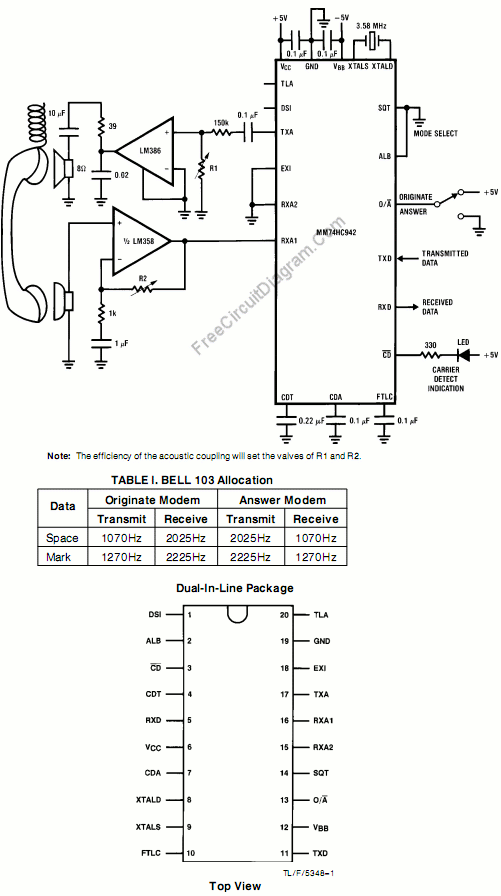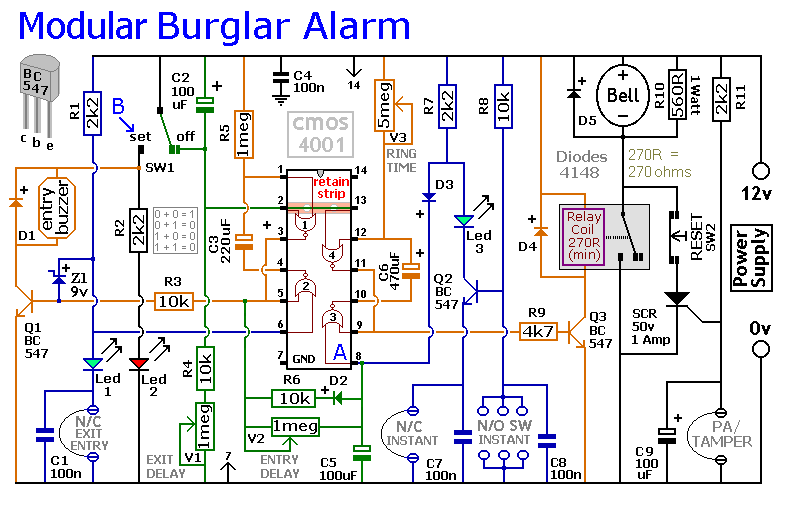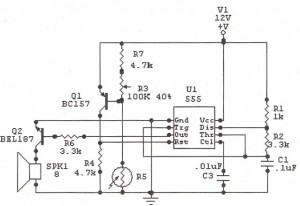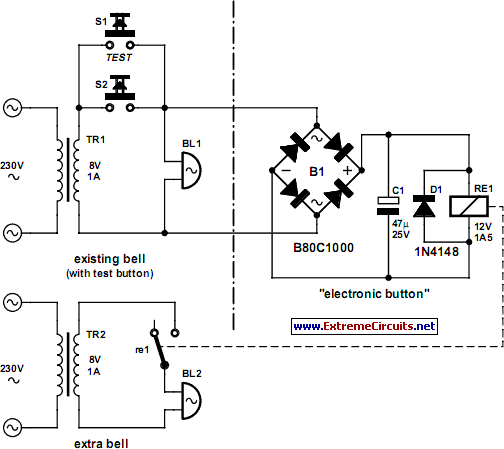
Piezoelectric alarm rings clear as a bell

A common piezoelectric alarm, such as the Murata PKB5-3A, possesses many valuable attributes, including compactness, lightweight design, efficiency, and reliability. However, the loud, high-pitched sound output can be irritating in many applications. The circuit provided transforms this buzzer into a more pleasant-sounding bell. At the core of the circuit is the widely used 555 timer (U1), configured as an astable multivibrator. The output low time generates a short pulse that initiates the bell strike, calculated as 0.693 × R2 × C1. For the specified component values, the strike time is 6.93 ms. The output high time represents the sustain period during which the bell tone's amplitude gradually decays, calculated as 0.693 × (R1 + R2) × C1. In this configuration, the high time is 236 ms. When U1’s output is low, the series transistor switch (Q1) activates through bias resistor R3, energizing the piezoelectric alarm (AL1) and charging capacitor C3. When U1’s output is high, Q1 turns off, causing the output of AL1 to decay until C3 discharges. This cycle then repeats. The values of the timing components R1, R2, and C1, along with decay capacitor C3, are not critical, allowing for various sound effects through experimentation.
The circuit utilizes the 555 timer in an astable mode to generate a square wave output that controls the operation of the piezoelectric alarm. The timer's configuration allows for continuous oscillation, creating a rhythmic sound output. The low time (6.93 ms) corresponds to the duration of the initial bell strike, while the high time (236 ms) dictates how long the bell tone is sustained before it begins to decay.
The transistor switch (Q1) plays a crucial role in controlling the alarm. When the 555 timer outputs a low signal, Q1 is turned on, allowing current to flow through the piezoelectric alarm, producing sound. The charging of capacitor C3 during this phase helps ensure that the alarm is energized adequately. Upon transitioning to a high output from the timer, Q1 is turned off, which stops current flow to the alarm and allows the sound to decay as C3 discharges.
The timing components R1, R2, and C1 can be selected based on the desired sound characteristics. For instance, increasing R1 or R2 will extend the duration of the high time, resulting in a longer sustain phase. Alternatively, adjusting C1 will influence both the strike and sustain times. Capacitor C3's value can also be modified to create different decay rates for the sound output, allowing for customization of the alarm's auditory profile.
This circuit design is straightforward, cost-effective, and adaptable, making it suitable for various applications where a less abrasive sound output is preferred.A common piezoelectric alarm, such as the Murata (Smyrna, GA) PKB5-3A shown, has many valuable attributes. It is compact, lightweight, efficient and reliable. However, the loud, high-pitched sound output can be quite irritating in many applications. The simple and inexpensive circuit provided here transforms this obnoxious little buzzer into a ple asantsounding bell ( see the figure ). At the heart of the circuit is the popular 555 timer U1, which is configured as an astable multivibrator. The output low time is a short pulse that initiates the bell strike. The strike time is 0. 693 †” R2 †” C1. For the component values shown, the strike time is 6. 93 ms. The output high time is the sustain time during which the amplitude of the bell tone decays continuously.
The high time is 0. 693 †” (R1 + R2) †” (C1). For this circuit, the high time is 236 ms. When the output of U1 is low, the series transistor switch Q1 turns on through bias resistor R3 to energize the piezoelectric alarm AL1 and charge capacitor C3. When the output of U1 is high, Q1 is off and the output of AL1 decays until C3 is discharged. When C3 is discharged again, the cycle is repeated. The values of timing components R1, R2, and C1, along with decay capacitor C3, aren`t critical; various sound effects can be produced by experimenting with them.
🔗 External reference
The circuit utilizes the 555 timer in an astable mode to generate a square wave output that controls the operation of the piezoelectric alarm. The timer's configuration allows for continuous oscillation, creating a rhythmic sound output. The low time (6.93 ms) corresponds to the duration of the initial bell strike, while the high time (236 ms) dictates how long the bell tone is sustained before it begins to decay.
The transistor switch (Q1) plays a crucial role in controlling the alarm. When the 555 timer outputs a low signal, Q1 is turned on, allowing current to flow through the piezoelectric alarm, producing sound. The charging of capacitor C3 during this phase helps ensure that the alarm is energized adequately. Upon transitioning to a high output from the timer, Q1 is turned off, which stops current flow to the alarm and allows the sound to decay as C3 discharges.
The timing components R1, R2, and C1 can be selected based on the desired sound characteristics. For instance, increasing R1 or R2 will extend the duration of the high time, resulting in a longer sustain phase. Alternatively, adjusting C1 will influence both the strike and sustain times. Capacitor C3's value can also be modified to create different decay rates for the sound output, allowing for customization of the alarm's auditory profile.
This circuit design is straightforward, cost-effective, and adaptable, making it suitable for various applications where a less abrasive sound output is preferred.A common piezoelectric alarm, such as the Murata (Smyrna, GA) PKB5-3A shown, has many valuable attributes. It is compact, lightweight, efficient and reliable. However, the loud, high-pitched sound output can be quite irritating in many applications. The simple and inexpensive circuit provided here transforms this obnoxious little buzzer into a ple asantsounding bell ( see the figure ). At the heart of the circuit is the popular 555 timer U1, which is configured as an astable multivibrator. The output low time is a short pulse that initiates the bell strike. The strike time is 0. 693 †” R2 †” C1. For the component values shown, the strike time is 6. 93 ms. The output high time is the sustain time during which the amplitude of the bell tone decays continuously.
The high time is 0. 693 †” (R1 + R2) †” (C1). For this circuit, the high time is 236 ms. When the output of U1 is low, the series transistor switch Q1 turns on through bias resistor R3 to energize the piezoelectric alarm AL1 and charge capacitor C3. When the output of U1 is high, Q1 is off and the output of AL1 decays until C3 is discharged. When C3 is discharged again, the cycle is repeated. The values of timing components R1, R2, and C1, along with decay capacitor C3, aren`t critical; various sound effects can be produced by experimenting with them.
🔗 External reference
Warning: include(partials/cookie-banner.php): Failed to open stream: Permission denied in /var/www/html/nextgr/view-circuit.php on line 713
Warning: include(): Failed opening 'partials/cookie-banner.php' for inclusion (include_path='.:/usr/share/php') in /var/www/html/nextgr/view-circuit.php on line 713





